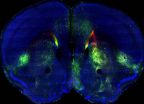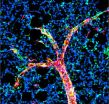(Press-News.org) PHILADELPHIA — A University of Pennsylvania research team has defined a possible new way to fight a disease that is currently treatable only with the most expensive drug available for sale in the United States. In a study published this month in Blood, the Penn team describes the strategy, based on the oldest part of the human immune system – called "complement" -- that could turn out to be less costly and more effective for the majority of patients with a rare blood disorder.
Complement is a network of more than 50 proteins in the blood and on cell surfaces that quietly cruise the body, keeping a low profile until triggered into action. On the other hand, this system can turn, contributing to a broad spectrum of immune, inflammatory, and age-related diseases.
John Lambris, PhD, the Dr. Ralph and Sallie Weaver Professor of Research Medicine in the Department of Pathology and Laboratory Medicine in the Perelman School of Medicine, studies this early-warning system and how to correct it when its response goes overboard.
This is known to be the case with paroxysmal nocturnal hemoglobinuria (PNH), a rare but life-threatening hematological disorder, which is estimated to affect between 1 and 5 per million people. In PNH, defective expression of regulatory proteins on the surface of blood cells leaves them vulnerable to complement attack. This can lead to premature death of the red blood cells, a process called hemolysis, which clinically results in severe anemia and contributes to a high risk of clotting.
Lambris and Daniel Ricklin, PhD, research assistant professor of Pathology and Laboratory Medicine, are developing novel therapeutics to tame this inappropriate complement activation and protect cell surfaces from attack.
Eculizumab (Soliris, an Alexion Pharmaceuticals drug) -- to date the only approved therapeutic for PNH -- reduces hemolysis and gives relief from blood transfusions for most PNH patients. However, Eculizumab is costly (currently the most expensive drug used in the US at more than $400,000 per year per patient), and one third of PNH patients continue to require blood transfusions to manage their anemia. As first described by co-author Antonio Risitano, MD, at the University of Naples in Italy, this non-response is due to fragments of complement C3 proteins on the surface of their red blood cells, which are eventually attacked by immune cells.
Lambris and colleagues have thought that inhibition of the "complement cascade" at the level of C3 proteins using small inhibitory molecules might be a superior strategy as it prevents both hemolysis and immune cell recognition while being potentially more cost-effective when compared to the current antibody-based treatment.
The team investigated the effect of a C3 inhibitor called Cp40 and its long-acting form PEG-Cp40 on self attack and resulting hemolysis using human PNH cells. Both compounds demonstrated inhibition of hemolysis and efficiently prevented deposition of C3 fragments on PNH red blood cells. In non-human primates, a single injection of PEG-Cp40 into the blood stream resulted in a longer time that the drug stayed in circulation, a property important for drug development.
"We think these two compounds are excellent and potentially cost-effective candidates for further clinical investigation," says Lambris, who hopes that the compounds could be tested in clinical trials by 2015.
INFORMATION:
Editor's Note: Lambris and Ricklin are the inventors of patents and/or patent applications owned by Penn that describe the use of complement inhibitors for therapeutic purposes. Lambris is a founder and equity holder of Amyndas Pharmaceuticals, which has exclusively licensed the Cp40 and PEG-Cp40 technologies from Penn and is developing complement inhibitors for clinical applications.
Other authors from Penn include Robert A. DeAngelis, Zhuoer Lin, Yijun Huang, and Edimara S. Reis.
This work was supported by grants from the National Institute of Allergy and Infectious Diseases (AI068730, AI030040, AI097805), the National Eye Institute (EY020633), and the National Institute of General Medicine (GM097747) and a pilot grant from the Penn-CHOP Blood Center for Patient Care and Discovery.
Penn Medicine is one of the world's leading academic medical centers, dedicated to the related missions of medical education, biomedical research, and excellence in patient care. Penn Medicine consists of the Raymond and Ruth Perelman School of Medicine at the University of Pennsylvania (founded in 1765 as the nation's first medical school) and the University of Pennsylvania Health System, which together form a $4.3 billion enterprise.
The Perelman School of Medicine has been ranked among the top five medical schools in the United States for the past 16 years, according to U.S. News & World Report's survey of research-oriented medical schools. The School is consistently among the nation's top recipients of funding from the National Institutes of Health, with $398 million awarded in the 2012 fiscal year.
The University of Pennsylvania Health System's patient care facilities include: The Hospital of the University of Pennsylvania -- recognized as one of the nation's top "Honor Roll" hospitals by U.S. News & World Report; Penn Presbyterian Medical Center; Chester County Hospital; Penn Wissahickon Hospice; and Pennsylvania Hospital -- the nation's first hospital, founded in 1751. Additional affiliated inpatient care facilities and services throughout the Philadelphia region include Chestnut Hill Hospital and Good Shepherd Penn Partners, a partnership between Good Shepherd Rehabilitation Network and Penn Medicine.
Penn Medicine is committed to improving lives and health through a variety of community-based programs and activities. In fiscal year 2012, Penn Medicine provided $827 million to benefit our community.
Making treatment of rare blood disorder more affordable and effective
2014-02-27
ELSE PRESS RELEASES FROM THIS DATE:
International study shows majority of children unaware of cigarette warning labels
2014-02-27
College Park, Md. -- An international study of children's perceptions of cigarette package warning labels found that the majority of children are unaware that they exist. Children in countries where larger warning labels are used, and which include a compelling graphic image of the negative health impacts of smoking, were more likely to be aware of and understand the health risks of tobacco products.
The study, led by Dina Borzekowski, Ed.D, in the University of Maryland School of Public Health (UMD SPH), and Joanna Cohen, PhD, Johns Hopkins Bloomberg School of Public ...
AGU: A 'shark's eye' view: Witnessing the life of a top predator
2014-02-27
HONOLULU – Instruments strapped onto and ingested by sharks are revealing novel insights into how one of the most feared and least understood ocean predators swims, eats and lives.
For the first time, researchers at the University of Hawaii and the University of Tokyo outfitted sharks with sophisticated sensors and video recorders to measure and see where they are going, how they are getting there, and what they are doing once they reach their destinations. (Go to http://www.youtube.com/watch?v=UHDOAmXRw-0&feature=youtu.be for video).
Scientists are also piloting ...
Mouse brain atlas maps neural networks to reveal how brain regions interact
2014-02-27
Different brain regions must communicate with each other to control complex thoughts and behaviors, but relatively little is known about how these areas organize into broad neuronal networks. In a study published by Cell Press February 27th in the journal Cell, researchers developed a mouse whole-brain atlas that reveals hundreds of neuronal pathways in a brain structure called the cerebral cortex. The online, open access, interactive image database, called the Mouse Connectome Project, provides an invaluable resource for researchers interested in studying the anatomy and ...
Study uncovers why autism is more common in males
2014-02-27
Males are at greater risk for neurodevelopmental disorders, such as autism spectrum disorder (ASD), than females, but the underlying reasons have been unclear. A large cohort study published by Cell Press on February 27th in the American Journal of Human Genetics provides compelling evidence in support of the "female protective model," which proposes that females require more extreme genetic mutations than do males to push them over the diagnostic threshold for neurodevelopmental disorders.
"This is the first study that convincingly demonstrates a difference at the molecular ...
Male goat essence really turns the females on
2014-02-27
Anyone who has ever spent time around goats knows they have a certain smell. By carefully analyzing eau de male goat, researchers reporting in the Cell Press journal Current Biology on February 27 have now identified a novel, citrus-scented ingredient that speaks directly to the females. It acts on female goats' brains to turn their reproductive systems on.
The study is the first to uncover a pheromone that activates the central reproductive axis, according to the researchers. Although the work was done in goats, the researchers say there is reason to think the findings ...
Supplement added to a standard diet improves health and prolongs life in mice
2014-02-27
Activating a protein called sirtuin 1 extends lifespan, delays the onset of age-related metabolic diseases, and improves general health in mice. The findings, which appear online February 27 in the Cell Press journal Cell Reports, point to a potentially promising strategy for improving health and longevity.
Sirtuin 1, or SIRT1, is known to play an important role in maintaining metabolic balance in multiple tissues, and studies in various organisms have shown that activating the protein can lead to many health benefits. Also, drugs that increase SIRT1 activity have been ...
By zooming in on arteries, researcher gets to the root of pulmonary hypertension
2014-02-27
You might think building muscle is a good thing, but that's often not so in the case of blood vessels in adults. In fact, excess smooth muscle is a root problem in many vascular diseases, as it causes arteries to constrict and blood pressure to rise. Now, an in-depth analysis of arterioles in mice with pulmonary hypertension explains how those misplaced smooth muscle cells develop.
The findings reported in the Cell Press journal Cell Reports on February 27th are important because nearly half of patients with pulmonary hypertension die within three years of diagnosis, ...
Yale study provides a breath of hope for pulmonary hypertension patients
2014-02-27
Most of us draw roughly 25,000 breaths a day without any thought. But for patients with pulmonary hypertension, a life-threatening increase in blood pressure in the lungs, even the smallest task can leave them gasping for air. A new study by researchers at Yale School of Medicine offers insight into the function of cells linked to this incurable and often fatal illness.
Published Feb. 27 in Cell Reports, the study is the first to explore the cellular mechanisms behind the changes in the way cells are organized in pulmonary arteries in pulmonary hypertension, which leaves ...
Internal logic: 8 distinct subnetworks in mouse cerebral cortex
2014-02-27
The mammalian cerebral cortex, long thought to be a dense single interrelated tangle of neural networks, actually has a "logical" underlying organizational principle, reveals a study appearing Feb. 27 in the journal Cell.
Researchers have identified eight distinct neural subnetworks that together form the connectivity infrastructure of the mammalian cortex, the part of the brain involved in higher-order functions such as cognition, emotion and consciousness.
"This study is the first comprehensive mapping of the most developed region of the mammalian brain: the cerebral ...
New discovery paves the way for medicine for people with hearing disabilities
2014-02-27
Researchers at Karolinska Institutet in Sweden have identified a biological circadian clock in the hearing organ, the cochlea. This circadian clock controls how well hearing damage may heal and opens up a new way of treating people with hearing disabilities.
Important body functions, such as sleep, the immune system, and hormone levels are controlled by a biological circadian clock. A team of researchers at Karolinska Institutet have now discovered that there is also a biological clock in the ear, controlled by genes known to regulate circadian rhythms. One of these ...





